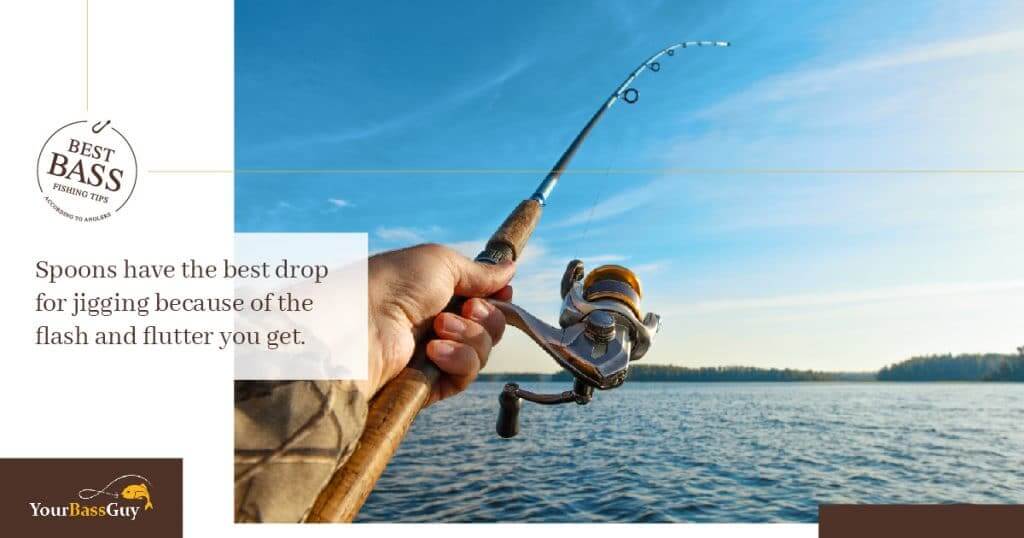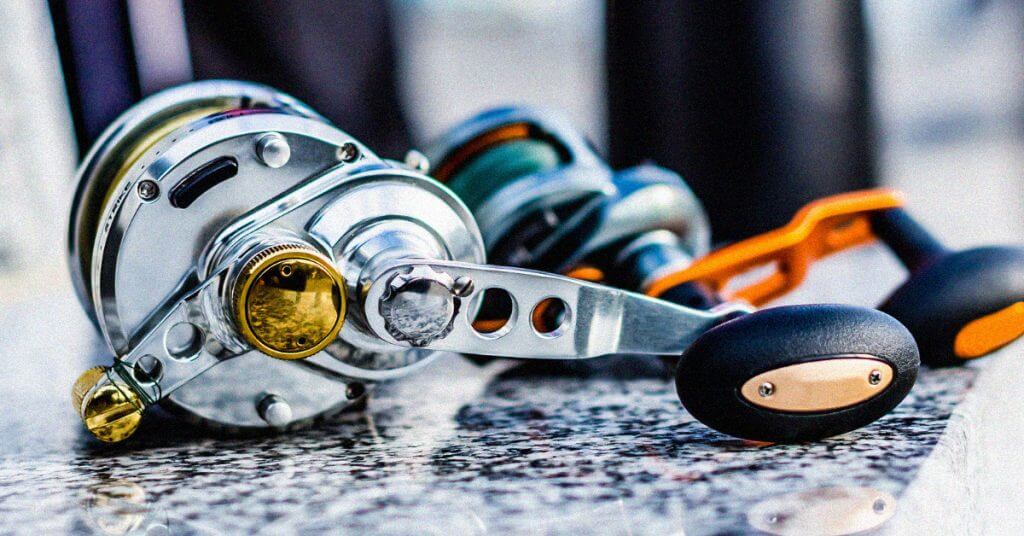Spoons are one of those lures that seem to stand the test of time.
No matter how advanced we get, spoon fishing for bass always sticks around, and we keep a few towards the bottom of our tackle box.
That said, no lure is good without the right strategy, and many people don’t know how to use spoons for bass fishing.
The good news is, spoons work for almost any bass fishing style, so you’re sure to find something that works for you. They come in many different shapes, sizes, and techniques. No matter what situation you find yourself in, there’s always a reason to use spoon lures.
My goal with this guide is to show you everything I know from what my grandfather and father taught me over the years.
They’re “old school” anglers, so spoons were a big lure for them, and outside of those and soft plastics – I don’t think I ever saw my dad fish with anything else.
Whether you’re a beginner or a seasoned expert, you should find something valuable in this guide of bass fishing tips.
Let’s jump into it!
In our Youtube video, Anglers.com writer Wesley tells us everything we need to know about rigging a spoon.
Different Types of Spoons

The most challenging aspect of spoons that I had to learn was the different types.
They almost all look the same, but there are slight variations that impact the presentation, performance, and casting of each, so you need to know the difference if you plan on implementing them properly into your fishing game.
Casting Spoons
These are the most basic types of fishing spoons. Casting spoons offer the simplest application because you’ll use them to cast and retrieve as you would with any other lure.
The problem here is, they don’t offer much of a presentation, and for that reason, many experts don’t recommend using them for bass fishing.
They say that these spoons work well for other fish and you’ll have a good chance of bringing in some panfish or trout. But if you’re spooning for bass, you might want to choose a different type.
You can usually identify a casting spoon because it will weigh up to two ounces and have a thicker body with a treble hook on one end.
Some will also have a tail, and this helps keep the weeds off the hook.
The reason casting hooks are a bit heavier than others is so you can get a longer and more accurate casting distance to cover more water since you’re simply casting and retrieving.
As I said, nothing too fancy here. These are basic and worth having, but they’re not the best way to go.
If I was to go with a casting spoon, I would choose a Krocodile design, which we’ll talk about shortly.
Jigging Spoons
If you consider yourself a bass angler, you’ve likely fished jigging spoons for bass.
This strategy is incredibly popular, and I wouldn’t even consider this to be a “type of spoon” because it’s more-so the main method of jigging for bass as far as I’m concerned.
The difference between casting and jigging is this. These are a bit more lightweight but still heavy enough that you can cast them if you want. Instead of casting them, though, you’ll drop them into the water vertically above where you believe to be a few bass.
The lure will fall like crazy towards the bottom, and you will jerk it back when you feel a bite. Most bass will take the bait as it’s falling towards the bottom of the water.
For jigging to work properly, you need a bit of depth in the water, so this strategy works better in open deep water, and it’s great for bringing in big bass.
One other thing you’ll want to keep in mind with vertical jigging is that it works best with a spinning rod setup.
When the bail is open, it’s easy for the lure to drop in the most natural way, but a casting reel might cause some resistance, which will screw up your presentation.
Slop Spoons (Weedless)
Some people call these slop spoons; others call them weedless spoons, whatever you call them, their purpose is obvious.
They’re essentially the opposite of the jigging spoon, and they’re meant to comb through weeds and cover in shallow water to get bass out into the open.
I’m a huge fan of this style spoon because I find these to work best during my favorite fishing season, which is early morning throughout the summer.
I love getting on the water at 6 am on a warm July morning when the sun is beating down on the water. This creates a huge advantage for me as the spoon angler.
The sun is your friend because it creates a bright and annoying reflection for the bass. As you’re plowing through the weeds while the bass are moving from dense vegetation in the morning to feed, you’re giving them exactly what they want—a quick snack.
Keep in mind that these are typically a lighter weight, so you won’t get as much of a casting distance, but you should be fishing the shoreline anyway, so it shouldn’t be a problem.
Trolling Spoons (Krocodile)

Trolling with spoons is another great way to create awesome action on the lure, a bright flash from the stainless, and it’s easy to control the depth, so you always stay where you want.
One of the best things about trolling is that you can use a downrigger or simply change the weight of your lure to keep the appropriate depth for what you’re looking to catch.
I also want to mention that there is a specific popular type of trolling spoon out there called a Krocodile or flutter spoon.
These have an “S” shape, so instead of simply flowing through the water, these lures will wiggle, which helps with the wounded fish presentation.
Spoon Fishing Strategies

We’ve talked about this a little, but let’s break it down in more detail. Spoon fishing for bass is a little less about the type and a bit more about the technique.
Let’s cover each presentation and how you can use it to catch some bass!
Vertical Jigging
First is the most popular bass spoon fishing technique. Spoons have the best drop for jigging because of the flash and flutter you get. You’ll want to rig up your spinning rod with a half-ounce jigging spoon and eight-pound test.
Take this strategy a bit deeper than you normally would because you want to give the lure enough time to work its magic.
It’s important to understand that this works the best on days when the sun is hot and bright.
That’s why I prefer fishing spoons in the early morning because the sun’s rays are the most powerful during this time.
The brighter the flash, the more attention you’ll attract, and ultimately, the more bass you’ll catch.
Swimming (Casting)
Always remember that the flash is where it’s at with spoons, so swimming works well if you can pump the rod as you do it.
As you pump your rod back and forth and the lure darts around the water, you’ll get that flash and the act of the “dying baitfish.”
Both of those factors combined equals good news for you.
If you’re planning to use this strategy, you’ll want to try and find as much clear water as possible and make sure to slow down your presentation enough to keep your spoon at your desired water depth.
If you go too fast, you’ll be too close to the surface.
Trolling
Turn on that outboard motor, drop the spoon into the water, and let it go.
This strategy is where I recommend the Krocodile spoon because the “S” shape helps create a brilliant wobble, and if you can find the right speed you’ll end up pulling bass into the boat with no problem.
The most important thing to remember about trolling is your depth, so size up or down your spoon based on what you’re trying to catch.
Popping
The reason spoons are so successful for bass is because they closely resemble shad and minnows, which are the ideal baitfish you want to replicate.
This makes popping work so well if you see bass congregating towards the surface.
When you see this, cast your spoon right past them, wait for a second with your tip high, and then pop the lure back. This presentation is fun, and remember that this works best on sunny days.
Pitching
Pitching is almost like jigging for bass, but instead, you’ll deliberately cast near structure, stumps, and vegetation.
This strategy is usually saved for soft plastics, but you can use spoons as well because they move quickly, and bass are opportunistic predators, so they’ll bite something even if they aren’t feeding.
A cool little trick that I have to entice them is to try and always have a little red on my spoon somewhere, even if I have to do it myself.
This tip helps the bass believe that the baitfish are injured, which will increase the likelihood of them striking.
Spoon Fishing For Bass: Some Extra Gear

Here’s a quick breakdown of the gear you should have to go with your spoon for bass fishing.
Spinning Rod/Reel – The best rod for spoon fishing is a spinning rod and reel combo. Spoons rely heavily on a smooth fall and retrieval, and that’s hard to get with a baitcaster.
8-10lb Test – You should never need to go any heavier than this for your line. It’s up to you whether you choose mono or braided, but if you’re sticking with the spinning reel, I would suggest keeping it simple with a monofilament line.
Line twist is a big issue with spoons also so you don’t want to go too light.
Bass Spoons Fishing Tips For Beginners
We’ve talked about a lot of things throughout this article, but I wanted to reserve a section here at the end to offer some last-minute tips and tricks to help go along with everything you’ve learned.
The anglers in my family taught me a lot about this type of fishing, and here’s what I know.
- Spoons tend to snag a lot, so I would suggest using a single hook setup over a treble hook
- The best time to fish with spoons is early-mid morning because the sun is bright
- If you’re consistently pitching around structure and heavy vegetation you might want to go with a braided line because it will make it easier to break free if you get hung up
- Popping works great in spring along tributaries and creek channels to larger bodies of water. While the bass are sitting there, getting oxygen from the groundwater flowing into the water, you can catch a ton of bass.
- You want to use a swivel because it will also help prevent line twist.
That’s all I’ve got for this one. Spoons are one of the best bass fishing lures and I hope this clears up any skepticism you have about this age-old fishing technique.
Sometimes we need to revert back to our roots to gain a better understanding of the sport as a whole.




